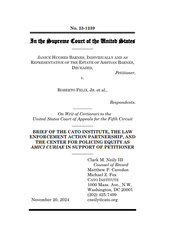In assessing the reasonableness of this use of deadly force, the Fifth Circuit applied the so-called moment of threat test. That minority approach limits a court to considering only whether a threat existed at the precise moment force is used, rather than the totality of the circumstances—as a court would have considered at common law. In this case, that meant the Fifth Circuit asked only whether Constable Felix was in danger the instant he opened fire, which he plainly was. The court disregarded other facts, like that the initial stop was for a petty offense and that Constable Felix placed himself in harm’s way by jumping onto the moving car.
What is more, the Founders entrusted juries of ordinary citizens with assessing the reasonableness of the use of deadly force. But that did not happen here because the Fifth Circuit granted Constable Felix qualified immunity and dismissed the claims against him. The Fifth Circuit’s moment of threat test also let it avoid the question of whether Mr. Barnes’s behavior was endangering anyone at the time Constable Felix killed him. This, too, contrasted with the common law’s approach, which limited the use of deadly force to cases where it was truly necessary.
The Cato Institute, together with the Law Enforcement Action Partnership (LEAP) and the Center for Policing Equity, filed Supreme Court amicus briefs at both the cert stage and the merits stage. The briefs argue that the Court should adopt the framework most federal circuit courts use to assess reasonableness. This means requiring judges and juries to consider the totality of the circumstances giving rise to the use of deadly force, including poor tactical decisions made by officers and the nature of the offense at issue.
Police officers are trained to presume the worst in even the most mundane encounters and react accordingly. When officers make poor tactical decisions, they put everyone at risk. The moment of threat test makes policing more dangerous, and the unnecessary use of deadly force undermines public confidence in law enforcement. Cato’s amicus brief urges the Court to reject the moment of threat test and instead uphold the common law doctrines that should govern the use of deadly force.



